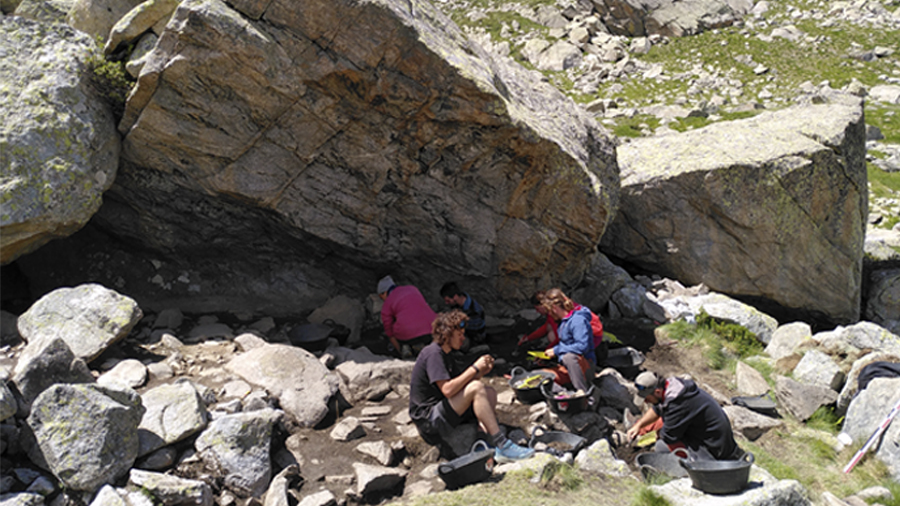Prehistory touching the sky: archaeological excavations resume at the Abric del Portarró
On Tuesday 4 July excavations began once again at the Abric del Portarró, a site containing the remains of prehistoric settlements located at an altitude of 2280 m in the middle of the Aigüestortes i Estany de Sant Maurici National Park. This is the highest altitude prehistoric archaeological dig in the Iberian Peninsula, carried out by the High Mountain Archaeology Group of the UAB-CSIC, with the support of the Aigüestortes i Estany de Sant Maurici National Park and the Ministry for Culture of the Government of Catalonia.

On Tuesday 4 July, archaeological excavations resumed at Abric del Portarró (Espot, Pallars Sobirà). This is an archaeological site with a long sequence of human occupation that extends at least from the Ancient Neolithic (7,200 years ago) to the 20th century, including the Late Neolithic (5,300-5,000 years ago), the Bronze Age (3,600-3,200 years ago), the Iberian, Roman and High Middle Ages. The remains are located both in the open air and in two small erratic blocks moved to the site by the last frosts, now more than 12,000 years ago.
The excavations at Abric del Portarró are part of a long-term research programme carried out by the High Mountain Archaeology Group (GAAM) of the Department of Prehistory of the Universitat Autònoma de Barcelona (UAB) and the Milà i Fontanals Institution (IMF-CSIC), with the support of the Aigüestortes i Estany de Sant Maurici National Park.
Within the framework of this programme, other sites were also excavated in the National Park, such as the Abric de l’Estany de la Coveta I (at an altitude of 2,450 m), the Abric de Les Obagues de Ratera (2,320 m) and the Cova del Sardo (1,790 m). This research has been decisive in changing the view of the high Pyrenean mountains held by archaeologists and the general public alike. Since the retreat of the ice after the last glacial period, human groups have frequented the different peaks of the Pyrenees. In the first phases, between 10,000 and 9,000 years ago, these were small groups of hunters who used the small shelters as temporary refuges on their expeditions. Later, from the beginning of the Neolithic period, 7,500 years ago, they incorporated livestock farming, and in some cases perhaps also agriculture, into the activities they carried out in this mountain area.
These studies also make it possible to document the human impact on high mountain environments over time, mainly by modifying its vegetation. The first indicators date back to the Neolithic, with traces of local deforestation around human settlements in order to open up small meadows and crops. From the end of the Neolithic, and especially during the Bronze Age, this impact on vegetation increased, reaching its peak in the Early Middle Ages, 900-800 years ago. Ongoing archaeological research is also making it possible to analyse how human presence in the high mountains coexisted with a climate that changed over the past 10,000 years, with fluctuations in both temperature and rainfall.
The archaeological excavations at the Abric del Portarró are being carried out within the framework of a contract from the Aigüestortes i Estany de Sant Maurici National Park and the four-year archaeology and palaeontology project "CLT/17/2022 - 122 Archaeology of pastoralism and prehistoric agriculture in the Western Pyrenees," funded by the Ministry for Culture of the Government of Catalonia.